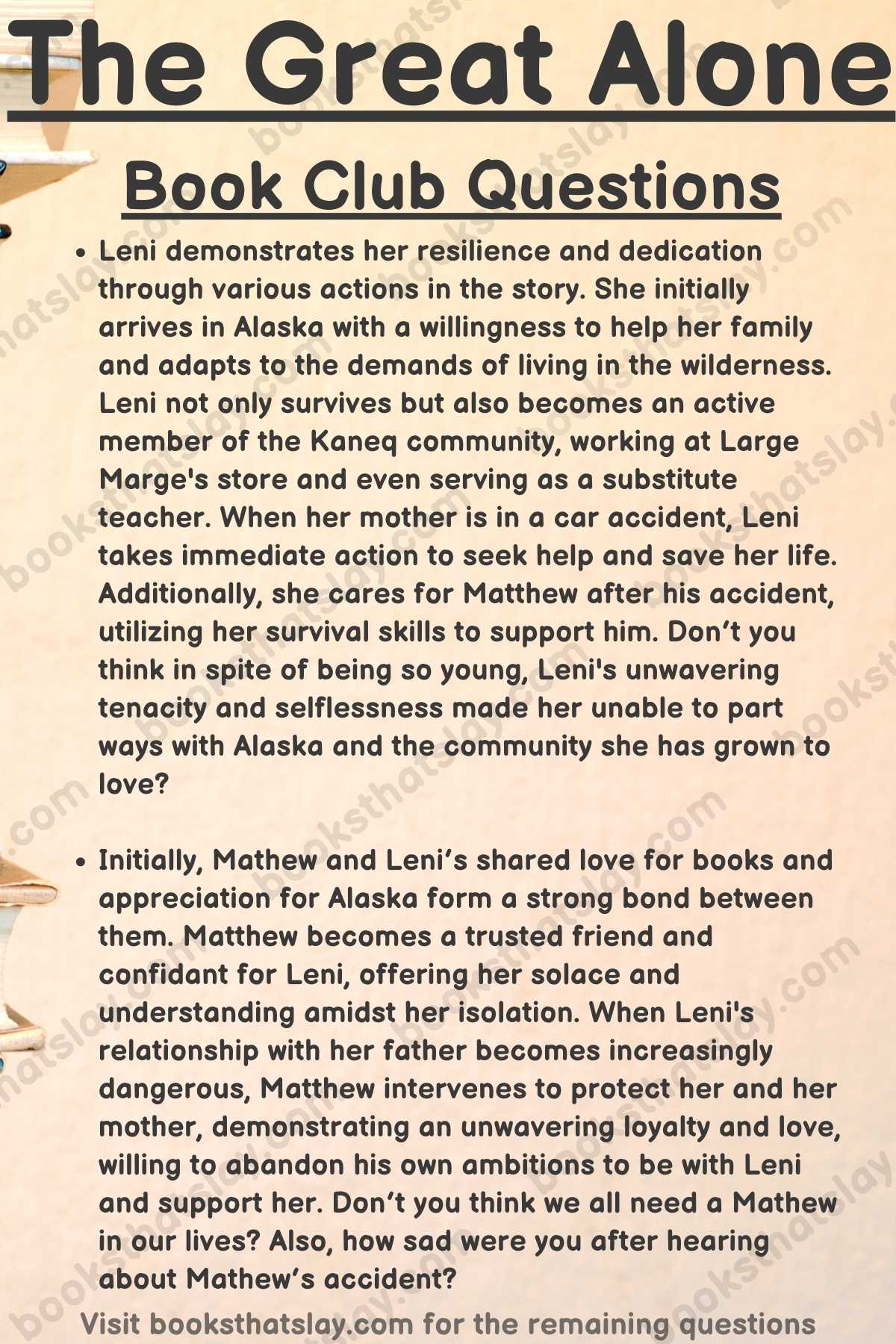10 The Great Alone Book Club Questions
Kristin Hannah’s The Great Alone plunges readers into the raw, unforgiving beauty of 1974 Alaska, a landscape as wild and unpredictable as the human heart.
The Allbright family, seeking refuge from their tumultuous lives, find themselves trapped in a battle for survival against both the elements and their own demons. Thirteen-year-old Leni, a young spirit yearning for freedom, discovers strength and resilience in the face of adversity.
As the harsh Alaskan winter closes in, so too do the family’s secrets, forcing them to confront the darkest corners of their souls.
Join us as we uncover why The Great Alone is a must-read for those seeking a profound exploration of resilience and the raw beauty of the human spirit.

The Great Alone Book Club Questions
- In “The Great Alone,” the harsh, unforgiving landscape of Alaska parallels the turbulent life of Leni Allbright. Discuss how Kristin Hannah uses the setting not just as a backdrop but as a catalyst for character development. How does the rugged wilderness influence the characters, particularly Leni, in their personal growth and survival? Consider discussing whether the novel suggests that adversity can lead to personal strength or if it portrays survival in a negative light.
- Ernt Allbright’s PTSD not only shapes his personality but also casts a long shadow over his family’s life. How does PTSD manifest in Ernt’s relationships with Leni and Cora, and how does it alter their family dynamics? Discuss how the novel addresses the ripple effects of trauma within a family. Can a family ever return to “normalcy” after such deep-seated trauma, and what might that new normal look like?
- The support from neighbors like Tom and Large Marge is pivotal for Leni’s ability to cope with her family situation. Analyze how the Kaneq community impacts Leni and Cora’s journey towards safety and independence. What does this suggest about the role of community in individual healing processes? Discuss whether the author portrays this community support as something unique to small or isolated communities like Kaneq.
- “The Great Alone” presents a detailed depiction of the cycle of domestic violence, showing Cora’s repeated returns to Ernt despite the danger. Discuss how Leni’s viewpoint on her parents’ relationship evolves throughout the novel and what finally motivates her to break this cycle. How does the novel address the complexities of leaving an abusive relationship, and what message does it send about the power dynamics involved?
- Communication plays a crucial role in how characters connect and endure hardships in the novel. Discuss the use of letters between Leni and Matthew as a form of maintaining connection and offering support. How do these letters aid in coping with isolation and grief for both characters? Additionally, explore how the act of writing influences Leni’s personal growth and helps her process her traumatic experiences.
- Leni’s relationship with her parents is complex and evolves dramatically throughout the novel. Discuss how Leni’s perception of her parents influences her actions and decisions. How does she navigate her loyalty between her mother, who is a victim, and her father, who is both a perpetrator and a victim of his own demons? Explore the ways in which children can inherit both the strengths and vulnerabilities of their parents.
- The isolation of Alaska plays a critical role in exacerbating Ernt’s PTSD and the family’s dynamics. Discuss how the setting of Alaska—its beauty and its brutality—acts as a mirror reflecting the internal struggles of the characters. How does Kristin Hannah portray the dual nature of isolation as both a refuge and a prison? Consider the psychological impacts of such isolation on all family members, not just Ernt.
- The women in “The Great Alone”—Leni, her mother Cora, and other female characters like Large Marge—often pull together to support one another. Analyze how these relationships shape the story and contribute to the characters’ survival strategies. How does feminine solidarity operate as a form of resistance against the male-dominated harshness they face?
- The idea of what constitutes a home is a central theme in the novel. Leni and her family move to Alaska searching for a new start, but they find both challenges and a new sense of belonging. Discuss how the characters’ understanding of home evolves throughout the novel. What does the book suggest about the elements that make a place truly a “home”?
- Nature is omnipresent in “The Great Alone,” serving both as a sanctuary and a battleground. Discuss how the wilderness in the novel acts as a symbol for the characters’ internal and external conflicts. How does the natural environment influence the story’s mood and the characters’ decisions? Consider elements like the changing seasons and the unpredictable wildlife in your discussion.
If you liked this set of questions here are a few other options you can consider.